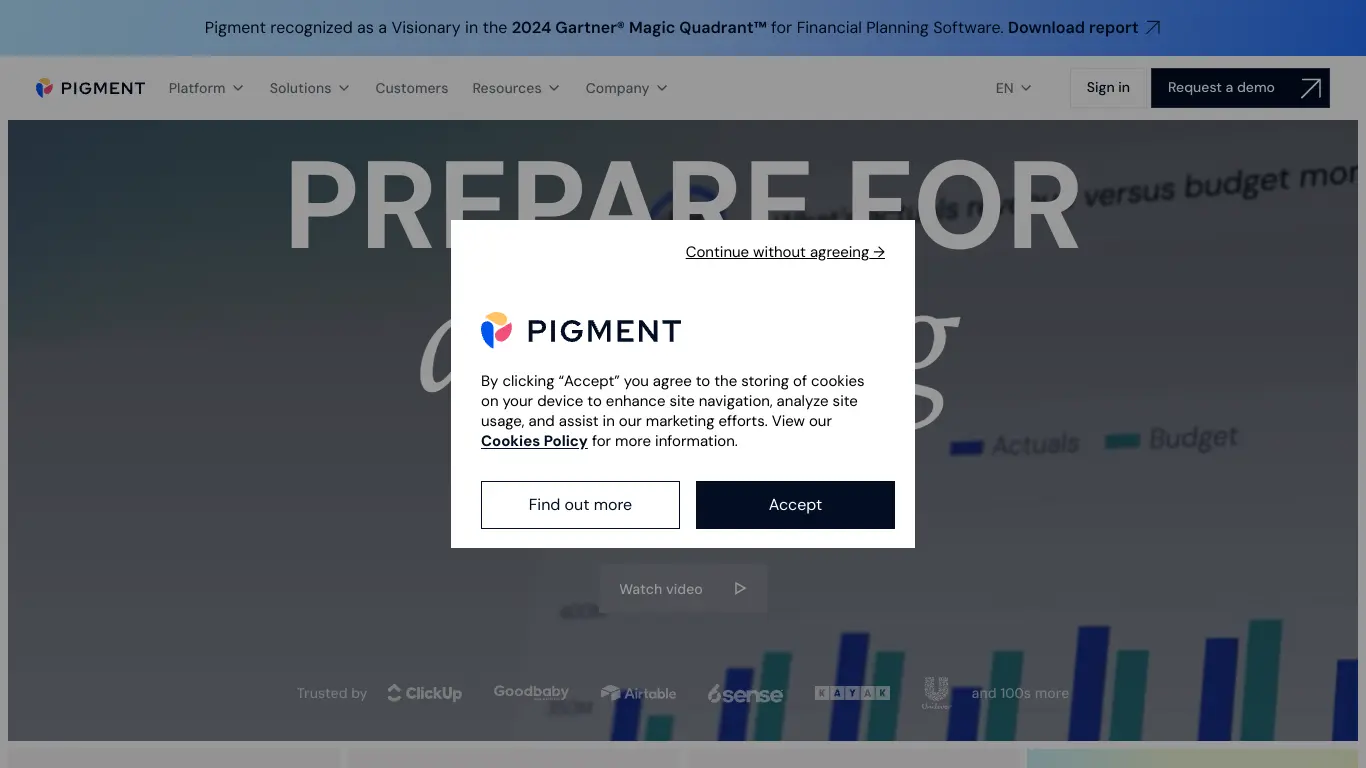Pigment is a visual business planning platform that connects financial and operational data to empower strategic decision-making across organizations.
Introduction to Pigment
Are you tired of wrestling with outdated spreadsheets for business planning? Do disconnected data sources and manual calculations keep your finance team working late into the night? If you’re nodding in agreement, you’re not alone. Many organizations struggle with financial planning and analysis tools that simply can’t keep pace with today’s business complexity. This is where Pigment steps in – a modern solution designed to transform how businesses approach planning, forecasting, and decision-making in an increasingly data-driven world.
What is Pigment and its Purpose?
Pigment is a business planning platform that combines the flexibility of spreadsheets with the power of modern technology to create a comprehensive solution for financial planning and analysis (FP&A). Unlike traditional planning tools, Pigment offers a unified approach that connects data across your organization, enabling real-time modeling, scenario planning, and collaborative decision-making.
The platform’s core purpose is to help organizations move beyond static spreadsheets and siloed planning processes. By providing a visually intuitive interface with powerful data modeling capabilities, Pigment aims to transform business planning from a cumbersome, backward-looking exercise into a dynamic, forward-thinking process that drives strategic decision-making.
As the Pigment team puts it, they’re on a mission to “empower better business decisions” by connecting financial and operational data in one place, enabling teams to understand the past, visualize the present, and plan for the future.
Who is Pigment Designed For?
Pigment targets mid-market and enterprise companies across various industries who need a robust planning solution. The platform is particularly valuable for:
- Finance Teams: CFOs, FP&A directors, and finance professionals who need to streamline budgeting, forecasting, and reporting processes
- Revenue Operations: Teams focused on optimizing revenue streams, sales performance, and customer metrics
- HR Departments: Human resources leaders managing headcount planning, compensation modeling, and workforce analytics
- Operations Teams: Operational leaders who need to connect financial outcomes with operational drivers
- Executive Leadership: C-suite executives who require a holistic view of business performance and future scenarios
What sets Pigment apart is its ability to serve both financial and non-financial stakeholders. The platform is designed to be accessible enough for business users while powerful enough for technical finance professionals – a rare combination in the planning software market.
Getting Started with Pigment: How to Use It
Getting started with Pigment involves a few key steps:
- Initial Setup: After signing up, users connect their data sources to Pigment. This includes ERP systems, CRM platforms, HR tools, and other business applications.
- Model Building: Working with Pigment’s team or independently, users create business models that reflect their organization’s structure and reporting needs.
- Dashboard Creation: Users build custom dashboards with visualizations that make their data accessible and actionable.
- Collaboration: Teams can then collaborate within the platform, creating scenarios, making comments, and sharing insights.
- Ongoing Planning: As business conditions change, users can update forecasts, run new scenarios, and adjust plans accordingly.
Pigment offers implementation support through its customer success team and partner network, helping organizations get up and running with configurations tailored to their specific needs. The platform is designed to be user-friendly but typically requires some initial training to maximize its capabilities.
Pigment’s Key Features and Benefits
Core Functionalities of Pigment
Pigment’s platform is built around several powerful capabilities that differentiate it from traditional planning tools:

Pigment creates a unified data model that pulls from multiple sources across your organization. This eliminates data silos and ensures everyone is working with consistent, up-to-date information.

The platform features a flexible modeling engine that allows users to create complex business models without coding. Key modeling features include:
- Driver-based planning
- Multi-dimensional analysis
- Time-series forecasting
- What-if scenario modeling
- Allocation logic for complex calculations

Pigment enables cross-functional planning with features designed for team collaboration:
- Role-based access controls
- Commenting and discussion threads
- Version control and change tracking
- Approval workflows for plan submissions
- Real-time collaboration on forecasts and scenarios

The platform transforms complex data into actionable insights through:
- Interactive dashboards and visualizations
- Custom chart building
- Data exploration and drill-down capabilities
- Presentation-ready reports

Pigment streamlines planning processes with:
- Automated data imports and exports
- Scheduled report generation
- Alert notifications for key metrics
- Process management tools
Advantages of Using Pigment
Organizations that implement Pigment typically experience several significant benefits:
Time Savings: According to customer testimonials on Pigment’s website, finance teams report reducing planning cycle times by 50-70%. This means less time spent on manual data manipulation and more time for strategic analysis.
Improved Accuracy: By eliminating manual data transfers and formula errors, Pigment helps organizations achieve more accurate forecasts and reduce reconciliation issues.
Better Decision-Making: With real-time data and scenario modeling capabilities, leaders can make more informed decisions based on current conditions rather than outdated information.
Increased Collaboration: The platform’s user-friendly interface and collaborative features enable broader participation in the planning process, breaking down silos between finance and operations.
Strategic Agility: Pigment allows organizations to adapt quickly to changing conditions by rapidly modeling new scenarios and adjusting forecasts.
Data Governance: The platform provides a single source of truth for planning data, improving consistency and accountability across the organization.
Main Use Cases and Applications
Pigment’s flexibility allows it to address numerous business planning needs, including:
| Use Case | Description | Key Features Utilized |
|---|---|---|
| Financial Planning & Analysis | Budgeting, forecasting, and variance analysis | Modeling engine, scenario planning, reporting |
| Revenue Planning | Sales forecasting, pricing optimization, revenue recognition | CRM integration, pipeline modeling, revenue analytics |
| Headcount Planning | Workforce budgeting, capacity planning, compensation modeling | HR system integration, position management, compensation analytics |
| Strategic Planning | Long-range planning, initiative tracking, investment analysis | Scenario modeling, strategic KPIs, multi-year forecasting |
| Marketing Performance | Campaign planning, ROI analysis, attribution modeling | Marketing system integration, campaign analytics, performance dashboards |
| Operational Planning | Resource allocation, capacity planning, operational KPI tracking | Operational data integration, driver-based modeling |
This versatility makes Pigment valuable across departments, helping organizations create an integrated planning process that connects financial outcomes with operational activities.
Exploring Pigment’s Platform and Interface
User Interface and User Experience
Pigment’s interface strikes a balance between power and usability – a crucial factor in planning software adoption. Here’s what stands out about the platform’s design:
Visual-First Approach
Unlike traditional planning tools that present users with endless rows and columns, Pigment leads with visualizations. The interface features:
- A clean, modern dashboard layout
- Colorful, intuitive charts and graphs (living up to the “Pigment” name)
- Interactive elements that respond to user input
- Contextual information that appears when needed
Intuitive Navigation
The platform organizes content in a logical hierarchy:
- Workspaces for different planning areas
- Models that contain the underlying calculations
- Dashboards that visualize the results
- Apps that package specific planning experiences
Familiar Spreadsheet Elements
For finance users comfortable with Excel, Pigment maintains familiar concepts like:
- Formula editing with similar syntax
- Cell-based operations
- Tabular data views when needed
- Keyboard shortcuts for power users
Customization Options
Users can tailor their experience with:
- Personalized dashboards
- Custom color schemes and branding
- Saved views and filters
- User-specific default settings
The overall user experience reflects Pigment’s philosophy of making complex planning accessible. While the platform offers sophisticated capabilities, it presents them in a way that doesn’t overwhelm users, gradually revealing complexity as needed.
Platform Accessibility
Pigment is designed to support different types of users and technical environments:
Web-Based Application
The platform runs primarily as a cloud-based web application, making it accessible from any modern browser without installing desktop software.
Mobile Responsiveness
While Pigment’s full modeling capabilities are optimized for desktop use, the platform offers mobile-responsive dashboards for executives who need to review information on the go.
Integration Capabilities
Pigment connects with other systems through:
- Pre-built connectors for popular business applications (Salesforce, NetSuite, Workday, etc.)
- API access for custom integrations
- File-based imports for systems without direct connections
- Export options to common formats like Excel and PDF
Accessibility Features
The platform includes:
- Keyboard navigation support
- Screen reader compatibility
- Color contrast options
- Text scaling
Localization
Pigment supports multiple languages and regional formatting options, making it suitable for global organizations.
Pigment Pricing and Plans
Subscription Options
Pigment uses a subscription pricing model typical of enterprise SaaS platforms. While the company doesn’t publish specific pricing on its website (following the “contact sales” approach common in enterprise software), industry research reveals the following structure:
Factors Affecting Pricing:
- Number of users (both creators and viewers)
- Data volume and complexity
- Required integrations
- Implementation services needed
- Contract length (annual vs. multi-year)
Based on public information and customer reviews, Pigment offers tiered plans that generally align with organization size and complexity:
| Plan Level | Typical Organization Size | Key Features | Approximate Price Range |
|---|---|---|---|
| Growth | Mid-market companies (100-500 employees) | Core planning capabilities, limited integrations, standard support | Starting at $30,000-$50,000 annually |
| Enterprise | Larger organizations (500+ employees) | Advanced modeling, multiple integrations, premium support | $50,000-$200,000+ annually |
| Global | Multi-national enterprises | Custom solutions, advanced security, dedicated support | Custom pricing |
Implementation services are typically priced separately and can range from $20,000 for simpler deployments to $100,000+ for complex enterprise implementations.
Free vs. Paid Features
Pigment does not offer a permanent free tier but does provide several pre-purchase evaluation options:
Demo Environment
Prospective customers can access a guided demo of the platform showcasing its core capabilities with sample data.
Proof of Concept (POC)
For qualified prospects, Pigment offers limited-time proof of concept deployments using the organization’s actual data to demonstrate value.
Trial Period
Some customers report negotiating trial periods as part of their purchase process, allowing teams to use the platform before committing to a full contract.
All paid plans include the core planning and modeling capabilities, with higher tiers adding:
- More advanced security features
- Higher data volume capacity
- Additional integration options
- Enhanced support levels
- Professional services hours
Pigment’s approach reflects its enterprise focus – rather than offering a limited free version, the company invests in showing the full potential of the platform to serious prospects.
Pigment Reviews and User Feedback
Pros and Cons of Pigment
Based on customer reviews from G2, Capterra, and other software review platforms, Pigment users highlight several strengths and limitations:

- Visual Interface: Users consistently praise Pigment’s intuitive, visually appealing interface that makes complex data more accessible.
- Modeling Flexibility: Finance professionals appreciate the powerful modeling capabilities that rival traditional spreadsheets while adding structure and governance.
- Collaboration Features: The ability for multiple stakeholders to work simultaneously on plans receives high marks, especially from larger organizations.
- Data Integration: Users value the platform’s ability to connect disparate data sources, creating a “single source of truth” for planning.
- Performance: Even with large datasets, reviewers note that Pigment maintains good performance, unlike spreadsheets that can become unwieldy.
- Customer Support: The Pigment team receives positive feedback for their responsiveness and willingness to address customer needs.

- Learning Curve: Some users find that despite the intuitive interface, mastering Pigment’s full capabilities requires significant training.
- Implementation Time: Several reviews mention that implementation can take longer than initially expected, particularly for complex use cases.
- Advanced Customization: Power users occasionally note limitations when attempting highly specialized or unique calculations.
- Mobile Experience: The mobile capabilities are mentioned as less robust than the desktop experience.
- Documentation: Some users report that documentation could be more comprehensive, particularly for advanced features.
- Price Point: As with most enterprise planning solutions, some organizations find the investment substantial, especially smaller companies.
User Testimonials and Opinions
Here are some representative quotes from actual Pigment users:
“Pigment has transformed our planning process from a quarterly spreadsheet nightmare into an ongoing strategic conversation. Our finance team now spends 60% less time on data preparation and much more time on analysis.” – Financial Planning Director, Technology Company
“The visual approach makes our financial data accessible to non-finance leaders. For the first time, our operations team is actively engaged in the planning process because they can actually understand what they’re looking at.” – CFO, Manufacturing Business
“Implementation was more complex than we anticipated, but the Pigment team stuck with us and delivered a solution that finally connected our sales, operations, and financial planning.” – VP of FP&A, SaaS Company
“After years of fighting with our old planning tool, Pigment feels like it was designed by people who actually understand how modern businesses operate. The scenario planning capabilities have been invaluable during uncertain economic conditions.” – Financial Analyst, Retail Organization
According to G2 reviews, Pigment currently holds an impressive 4.6/5 rating, with particularly high scores for ease of use (4.5/5) and quality of support (4.7/5). The platform performs slightly lower on value for money (4.2/5), reflecting its premium positioning in the market.
Pigment Company and Background Information
About the Company Behind Pigment
Pigment was founded in 2019 by Eléonore Crespo and Romain Niccoli, who brought complementary expertise to the company. Crespo’s background as an investor at Index Ventures and a financial analyst at Google, combined with Niccoli’s technical experience as co-founder and former CTO of Criteo (a successful adtech company), formed the foundation for Pigment’s approach to business planning.
Company Growth and Funding
Pigment has experienced rapid growth since its founding, reflecting strong market demand for modern planning solutions:
| Funding Round | Date | Amount | Lead Investors |
|---|---|---|---|
| Seed | October 2019 | $3.7M | FirstMark Capital |
| Series A | December 2020 | $26M | Blossom Capital |
| Series B | November 2021 | $73M | Greenoaks |
| Series C | May 2023 | $65M | IVP |
This funding trajectory has allowed Pigment to expand quickly, growing from a small Paris-based startup to a global organization with offices in New York, London, and Paris. The company has used this capital to build its team, develop the product, and expand its market presence.
Company Culture and Vision
Pigment emphasizes a product-led culture with a strong focus on user experience and technical excellence. The company’s name itself reflects its mission to bring color and clarity to what has traditionally been a monochrome world of financial planning.
The leadership team has articulated a vision of “empowering better business decisions” by connecting financial and operational planning in one platform. This philosophy guides product development and positions Pigment as more than just a financial tool but rather a comprehensive business planning solution.
As of the latest public information, Pigment employs approximately 350 people globally and continues to grow its team, particularly in product development and customer success roles.
Pigment Alternatives and Competitors
Top Pigment Alternatives in the Market
The business planning software market offers several alternatives to Pigment, each with different strengths and focus areas:
1. Anaplan
Anaplan is one of the most established players in the connected planning space. With a strong enterprise focus, Anaplan offers extensive modeling capabilities and a large ecosystem of partners and templates.
2. Planful
Planful (formerly Host Analytics) provides a comprehensive financial planning platform with strengths in financial consolidation and close management alongside planning and budgeting.
3. Workday Adaptive Planning
Workday Adaptive Planning offers planning solutions that integrate deeply with Workday’s HCM and financial management systems, making it particularly strong for Workday customers.
4. Board
Board combines business intelligence, planning, and predictive analytics in one platform, with particular strength in operational planning scenarios.
5. Jedox
Jedox offers planning, analysis, and reporting with a focus on Excel compatibility and self-service capabilities for business users.
6. Vena Solutions
Vena takes an Excel-centric approach, adding workflow, data management, and collaboration features around the familiar spreadsheet interface.
Pigment vs. Competitors: A Comparative Analysis
How does Pigment stack up against these alternatives? Here’s a comparative analysis based on key dimensions:
| Platform | User Experience | Modeling Power | Implementation Speed | Enterprise Readiness | Best For |
|---|---|---|---|---|---|
| Pigment |      |
    |
    |
    |
Organizations seeking visual, collaborative planning with modern UX |
| Anaplan |    |
     |
   |
     |
Complex enterprise planning with extensive modeling requirements |
| Planful |     |
    |
    |
    |
Finance-led planning with strong consolidation needs |
| Workday Adaptive |     |
    |
    |
    |
Workday customers seeking integrated planning |
| Board |    |
     |
   |
    |
Organizations seeking combined BI and planning capabilities |
| Jedox |    |
    |
    |
   |
Excel-oriented teams requiring more governance |
| Vena |     |
   |
     |
   |
Excel-centric organizations with simpler planning needs |
Key Differentiators for Pigment:
- Modern, Visual Interface: Pigment consistently ranks highest for user experience, making it particularly appealing for organizations seeking broader adoption beyond finance.
- Balance of Power and Usability: While some competitors offer more modeling depth (Anaplan) or faster implementation (Vena), Pigment strikes a balance between powerful capabilities and user-friendly design.
- Built for Modern Organizations: As a newer platform, Pigment was designed specifically for today’s business challenges, without legacy architecture constraints.
- Collaborative Focus: Pigment places greater emphasis on cross-functional collaboration than most alternatives, which tend to be more finance-centric.
When choosing between Pigment and alternatives, organizations should consider their specific planning needs, technical resources, and the importance of user adoption across departments.
Pigment Website Traffic and Analytics
Website Visit Over Time
Pigment’s website (www.pigment.com) has shown consistent growth in traffic, reflecting increasing market interest in modern planning solutions. According to public web analytics data, the site has demonstrated impressive momentum:
| Time Period | Monthly Visits (Approx.) | Growth Rate |
|---|---|---|
| Q1 2021 | 15,000 – 20,000 | Baseline |
| Q1 2022 | 45,000 – 55,000 | +175% YoY |
| Q1 2023 | 90,000 – 110,000 | +100% YoY |
| Recent | 130,000 – 150,000 | +45% YoY |
This traffic growth coincides with Pigment’s funding rounds and expanded marketing efforts, showing strong market interest in their offering. The website features a significant amount of content including product information, customer stories, and thought leadership articles aimed at financial planning professionals.
Geographical Distribution of Users
Pigment’s website traffic reflects its global market presence, with notable concentrations in key markets:
Top Regions by Traffic Share:
- North America: ~40%
- Western Europe: ~35%
- United Kingdom: ~12%
- Asia-Pacific: ~8%
- Rest of World: ~5%
This distribution aligns with Pigment’s office locations in New York, Paris, and London, as well as the company’s focus on markets with high concentrations of mid-market and enterprise businesses seeking planning solutions.
Main Traffic Sources
Pigment’s web traffic comes from diverse sources, demonstrating a multi-channel marketing approach:
Traffic Sources by Percentage:
- Organic Search: 35-40%
- Direct Navigation: 25-30%
- Referral Traffic: 15-20%
- Paid Search: 10-15%
- Social Media: 5-8%
The strong organic search performance indicates effective SEO and content marketing strategies, while the healthy direct navigation numbers suggest growing brand recognition. Referral traffic includes mentions in industry publications, analyst reports, and partner websites.
Key search terms driving traffic include “business planning software,” “financial planning and analysis tools,” “FP&A software,” “Anaplan alternatives,” and “modern budgeting software” – reflecting both category searches and competitor comparison queries.
Frequently Asked Questions about Pigment (FAQs)
General Questions about Pigment
Q: What type of software is Pigment?
A: Pigment is a business planning platform that combines financial planning, analytics, and collaboration tools in one solution. It helps organizations create budgets, forecasts, and strategic plans with a visual, user-friendly approach.
Q: Is Pigment a BI (Business Intelligence) tool?
A: While Pigment includes visualization and analytics capabilities similar to BI tools, it’s primarily focused on forward-looking planning rather than historical reporting. However, it does incorporate historical data analysis as a foundation for projections and forecasts.
Q: How long has Pigment been around?
A: Pigment was founded in 2019 by Eléonore Crespo and Romain Niccoli. Despite being relatively new to the market, the company has grown rapidly and established itself as a significant player in the business planning space.
Q: What size companies use Pigment?
A: Pigment’s customer base primarily consists of mid-market and enterprise organizations, typically with 100+ employees. Their clients range from high-growth technology companies to established multinational corporations across various industries.
Feature Specific Questions
Q: Does Pigment replace Excel for financial planning?
A: Pigment aims to replace Excel for organizational planning processes while maintaining familiar spreadsheet concepts. While some finance teams may still use Excel for specific analyses, Pigment provides a more structured, collaborative, and scalable environment for company-wide planning.
Q: What data sources can connect to Pigment?
A: Pigment offers integrations with major business systems including:
- ERP systems (NetSuite, SAP, Oracle)
- CRM platforms (Salesforce, HubSpot)
- HR and payroll systems (Workday, ADP)
- Marketing platforms (Google Analytics, Marketo)
- Databases and data warehouses (Snowflake, BigQuery)
- Custom applications via API
- Flat file imports (CSV, Excel)
Q: Can Pigment handle revenue forecasting?
A: Yes, revenue forecasting is one of Pigment’s core use cases. The platform can model complex revenue scenarios including subscription businesses, usage-based pricing, sales pipeline conversion, and multi-product forecasting with various drivers and assumptions.
Q: Does Pigment support rolling forecasts?
A: Yes, Pigment is well-suited for rolling forecast processes. The platform allows organizations to continuously update forecasts as new data becomes available, shifting time horizons automatically and maintaining forecast windows that extend consistently into the future.
Pricing and Subscription FAQs
Q: How much does Pigment cost?
A: Pigment pricing starts around $30,000 annually for smaller implementations and increases based on the number of users, data volume, and complexity of use cases. Enterprise implementations typically range from $50,000 to $200,000+ annually. Custom pricing is available for specific requirements.
Q: Does Pigment offer a free trial?
A: Pigment doesn’t offer a standard free trial but provides demonstrations and proof-of-concept implementations for qualified prospects. These allow potential customers to experience the platform with their own data before making a purchase decision.
Q: What is included in the Pigment subscription?
A: Pigment subscriptions typically include:
- Access to the platform for licensed users
- Standard integrations and data connections
- Regular product updates and enhancements
- Technical support
- Cloud hosting and data storage
- Basic training resources
Implementation services, custom integrations, and advanced training are usually priced separately.
Support and Help FAQs
Q: What kind of support does Pigment offer?
A: Pigment provides multiple support channels:
- Customer success managers for strategic guidance
- Technical support team for platform issues
- Knowledge base and documentation
- Training resources and webinars
- User community for peer assistance
- Professional services for implementation and customization
Q: How long does Pigment implementation take?
A: Implementation timelines vary based on complexity:
- Basic implementations: 4-8 weeks
- Standard implementations: 2-4 months
- Complex enterprise deployments: 4-6+ months
Factors affecting implementation time include the number of use cases, data sources, customizations required, and organizational readiness.
Q: Does Pigment offer training?
A: Yes, Pigment provides various training options:
- Standard onboarding training for new customers
- Role-based training for different user types
- Advanced modeling training for power users
- Administrator training for platform management
- Custom training programs for specific requirements
- Ongoing education through webinars and knowledge base
Conclusion: Is Pigment Worth It?
Summary of Pigment’s Strengths and Weaknesses
After thoroughly examining Pigment’s capabilities, user feedback, and market position, here’s a balanced assessment of its key strengths and weaknesses:

- Modern, Intuitive Interface: Pigment stands out for its visually appealing, user-friendly design that makes complex planning more accessible to non-finance users.
- Powerful Modeling with Accessibility: The platform successfully balances sophisticated modeling capabilities with usability, offering depth for power users without overwhelming occasional users.
- Collaborative Planning Approach: Pigment excels at connecting stakeholders across departments, breaking down silos between finance, operations, and other business functions.
- Visual Data Exploration: The emphasis on visualization helps users discover insights and understand relationships in their data more effectively than traditional planning tools.
- Growth Momentum: As a newer platform with substantial funding, Pigment is innovating rapidly and responding to customer feedback with regular enhancements.

- Investment Required: Pigment represents a significant financial commitment, particularly for smaller organizations or those transitioning from spreadsheet-based planning.
- Implementation Complexity: While more streamlined than some legacy solutions, implementing Pigment still requires dedicated resources and change management.
- Maturity Level: As a newer platform, Pigment has less established patterns and pre-built content than some competitors with longer market presence.
- Learning Curve: Despite its intuitive interface, mastering Pigment’s full capabilities requires training and practice, especially for advanced modeling scenarios.
Final Recommendation and Verdict
Is Pigment worth the investment? Based on my analysis, Pigment represents a compelling option for organizations ready to modernize their planning processes, particularly those matching these profiles:

- Mid-size to enterprise organizations struggling with spreadsheet limitations or legacy planning tools
- Companies seeking to connect financial and operational planning in one platform
- Businesses that value visual clarity and cross-functional collaboration
- Organizations with complex modeling needs that require both power and usability
- Finance teams looking to spend less time on data preparation and more on analysis

- You’re a small organization with basic planning needs that spreadsheets can handle effectively
- Your budget constraints make the investment challenging to justify
- You need specialized capabilities in financial consolidation or regulatory reporting
- You’re heavily invested in the Microsoft ecosystem and prioritize Power BI/Excel integration
The verdict? Pigment delivers significant value for organizations ready to invest in modern planning capabilities. Its approach represents the future direction of business planning – visual, connected, and collaborative. While the investment is substantial, the potential returns in time savings, improved decision-making, and strategic agility make it worthwhile for organizations that align with its target profile.
As with any significant business software decision, the best approach is to evaluate Pigment against your specific requirements, perhaps through a proof of concept, and consider both immediate needs and long-term planning evolution.






















